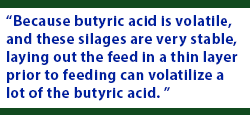
Wet small grain silages: How do I feed these?
 By Pat Hoffman, Vita Plus dairy technical specialist, and Dr. Michelle Der Bedrosian, Vita Plus forage products and dairy technical specialist
By Pat Hoffman, Vita Plus dairy technical specialist, and Dr. Michelle Der Bedrosian, Vita Plus forage products and dairy technical specialistThe snow melted and revealed widespread alfalfa winterkill. Now we are going through one of the wettest springs in recent memory. However, dairy farmers are innovative and resourceful, and many producers will be making silage from crops other than corn and alfalfa this year.
Small grain silages offer many benefits: decent yields, digestible fiber, available sugars for a robust fermentation and a good source of protein. This year, many producers will rely on small grain silages as a primary forage for lactating dairy cows. However, because of the wet harvest conditions, reports indicate small grain silages are coming off the field wet, which can predispose these silages to Clostridia growth and butyric acid fermentations.
Any wet crop with a slow pH drop is susceptible to the growth of Clostridia. Alfalfa haylage often has a high pH, typically above 4.2. It has more minerals (specifically calcium) and more proteins, which help buffer a pH drop, and less soluble sugars than small grain silages. For this reason, the pH of small grain silages are typically lower than that of haylage, sometimes less than 4.0.
 Butyric small grain silages can look different from butyric alfalfa haylage. Intuitively, knowing that Clostridia are sensitive to pH, and the pH of small grains are typically lower than alfalfa, one would think that Clostridia are not as big a deal in small grain silage as they are in haylage. Our experience says something different. Although no published research directly compares the two, animals seem to react differently to butyric haylage compared to butyric small grain silage or grass silages. Historically, we get more reports of depressions in dry matter intake (DMI), and even silage-induced ketosis, when butyric small grain silages or grass silages are fed to lactating dairy cows. Because butyric acid in small grain silages produces ketones, in addition to the regular ketones produced during fat mobilization, wet small grain silages containing butyric acid should not be fed to transition cows as it may increase the risk of ketosis.
Butyric small grain silages can look different from butyric alfalfa haylage. Intuitively, knowing that Clostridia are sensitive to pH, and the pH of small grains are typically lower than alfalfa, one would think that Clostridia are not as big a deal in small grain silage as they are in haylage. Our experience says something different. Although no published research directly compares the two, animals seem to react differently to butyric haylage compared to butyric small grain silage or grass silages. Historically, we get more reports of depressions in dry matter intake (DMI), and even silage-induced ketosis, when butyric small grain silages or grass silages are fed to lactating dairy cows. Because butyric acid in small grain silages produces ketones, in addition to the regular ketones produced during fat mobilization, wet small grain silages containing butyric acid should not be fed to transition cows as it may increase the risk of ketosis.
The most important factor to prevent butyric acid formation in small grain silages is to ensure the crop is ensiled at the proper DM. If the small grain silage is too dry at ensiling, the crop will be difficult to pack because it has hollow stems. Alfalfa does not have this issue. To optimize packing density and minimize butyric fermentations, small grains should be ensiled at 33% to 36% DM (wetter than alfalfa) and chopped at a half-inch of the theoretical length of cut (TLOC) or shorter if the crop starts to get dry.
 Sometimes Mother Nature does not cooperate, silages are ensiled too wet and we get some butyric acid formation. While silages with butyric acid should not be fed to transition cows, other groups of dairy cattle can tolerate forages containing butyric acid. Target these forages to heifers or late-lactation cows. Also, the butyric acid content of theses silages can be reduced by airing it out. Because butyric acid is volatile, and these silages are very stable, laying out the feed in a thin layer prior to feeding can volatilize a lot of the butyric acid.
Sometimes Mother Nature does not cooperate, silages are ensiled too wet and we get some butyric acid formation. While silages with butyric acid should not be fed to transition cows, other groups of dairy cattle can tolerate forages containing butyric acid. Target these forages to heifers or late-lactation cows. Also, the butyric acid content of theses silages can be reduced by airing it out. Because butyric acid is volatile, and these silages are very stable, laying out the feed in a thin layer prior to feeding can volatilize a lot of the butyric acid.
Finally, the ensiling DM content is the primary management factor that controls the rate and extent the pH declines in silages. No inoculant can alter this event in wet silages and/or totally prevent the growth of Clostridia. Nonetheless, dropping the pH quickly is still important for all silages, and an inoculant may help in this regard.
Unfortunately, at times, dairy farming seems to be more of an art than a science, but, at the end of the day, we have to feed what we have available. A little bit of knowledge on how to make the most out of small grain silages can go a long way.
| Category: |
Forage Foundations Forage harvesting Silages |

